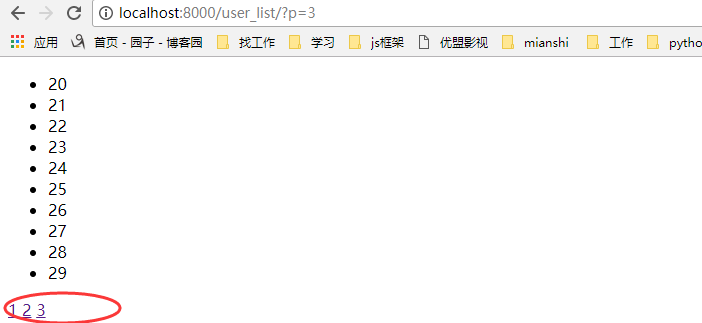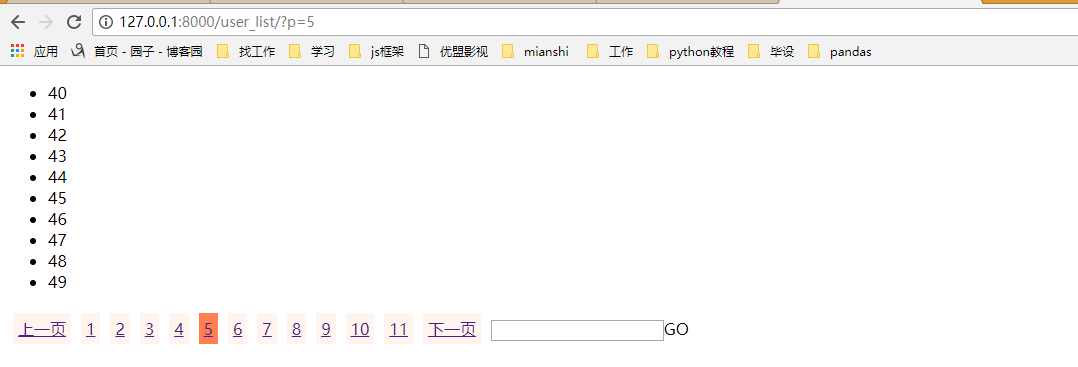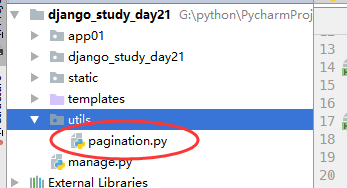Django学习---自定义分页
自定义分页
简单例子:
urls.py:
from django.contrib import admin
from django.urls import path
from django.conf.urls import url,include
from app01 import views
urlpatterns = [ url(r'^user_list/',views.user_list),
]
先固定写死数据:view.py:
LIST = []
for i in range(100):
LIST.append(i)
def user_list(request):
current_page = request.GET.get('p',1)
current_page = int(current_page)
start = (current_page-1)*10
end = current_page * 10
data = LIST[start:end]
return render(request,'user_list.html',{'li':data})
user_item.py
<!DOCTYPE html>
<html lang="en">
<head>
<meta charset="UTF-8">
<title>Title</title>
</head>
<body>
<ul>
{% for item in li %}
{% include 'li.html' %}
{% endfor %}
</ul>
<div>
<a href="/user_list/?p=1">1</a>
<a href="/user_list/?p=2">2</a>
<a href="/user_list/?p=3">3</a>
</div>
</body>
</html>
显示效果:

我们都知道后台穿过来的是一个字符串,如果我们把那些a标签从后台传过来,那会是什么样的呢?
views.py:
def user_list(request):
current_page = request.GET.get('p',1)
current_page = int(current_page)
start = (current_page-1)*10
end = current_page * 10
data = LIST[start:end]
page_str = '''
<a href="/user_list/?p=1">1</a>
<a href="/user_list/?p=2">2</a>
<a href="/user_list/?p=3">3</a>
'''
#return render(request,'user_list.html',{'li':data})
return render(request,'user_list.html',{'page_str':page_str,'li':data})
html.py:
<div>
{{ page_str }}
</div>
显示效果:

这里可以引入一个知识:XSS攻击:即评论,输入框等输入一些脚本,for循环。
如果想要显示的话:
第一种方法:
{{ page_str|safe }}
第二种方法:
from django.utils.safestring import mark_safe
page_str = '''
<a href="/user_list/?p=1">1</a>
<a href="/user_list/?p=2">2</a>
<a href="/user_list/?p=3">3</a>
'''
page_str = mark_safe(page_str)
分页1.0版本:使用固定的列表数据,然后获得页数,
views.py:
def user_list(request):
current_page = request.GET.get('p',1)
current_page = int(current_page)
start = (current_page-1)*10
end = current_page * 10
data = LIST[start:end] all_count = len(LIST)
count,y = divmod(all_count,10)
if y:
count+=1 page_list = []
for i in range(1,count+1):
if i == current_page:
temp = '<a class="page active" href="/user_list/?p=%s">%s</a>' % (i, i)
else:
temp = '<a class="page" href="/user_list/?p=%s">%s</a>' %(i,i)
page_list.append(temp) page_str = "".join(page_list) return render(request,'user_list.html',{'page_str':page_str,'li':data})
html文件:
<!DOCTYPE html>
<html lang="en">
<head>
<meta charset="UTF-8">
<title>Title</title>
<style>
.pagination .page{
display: inline-block;
padding:5px;
background-color: seashell;
margin:5px;
}
.pagination .active{
background-color: coral;
}
</style>
</head>
<body>
<ul>
{% for item in li %}
{% include 'li.html' %}
{% endfor %}
</ul>
<div class="pagination">
{{ page_str|safe }}
</div>
</body>
</html>
显示效果:

上面的分页代码我们在数据少的时候将就一下,但是如果一旦我们的数据多了,那我们如果一下子把所有的页数都显示在html中,那显然是不合适的,那我们应该要隐藏多的页数
那我们需要该for循环,显示当前页的前五个和后五个,来我们改写一些views里面的函数:
def user_list(request):
current_page = request.GET.get('p',1)
current_page = int(current_page)
page_size = 10#页面一次显示多少条数据
page_num=11#页面显示的页数
start = (current_page-1)*page_size
end = current_page * page_size
data = LIST[start:end] all_count = len(LIST)
count,y = divmod(all_count,page_size)
if y:
count+=1 page_list = []
if count <= 11:
start_index = 1
end_index = count+1
elif count > 11:
if current_page <= (page_num+1)/2:
start_index = 1
end_index = page_num + 1
elif (current_page+(page_num-1)/2) > count :
start_index = count-page_num+1
end_index = count + 1
else:
start_index = current_page - (page_num-1)/2
end_index = current_page + (page_num+1)/2
if current_page != 1:
prev_page = '<a class="page" href="/user_list/?p=%s">上一页</a>' % (current_page-1)
page_list.append(prev_page)
for i in range(int(start_index),int(end_index)):
if i == current_page:
temp = '<a class="page active" href="/user_list/?p=%s">%s</a>' % (i, i)
else:
temp = '<a class="page" href="/user_list/?p=%s">%s</a>' %(i,i)
page_list.append(temp)
if current_page != count:
after_page = '<a class="page" href="/user_list/?p=%s">下一页</a>' % (current_page + 1)
page_list.append(after_page) jump = '''
<input type="text" /><a onclick='jumpTo(this,"/user_list/?p=");'>GO</a>
<script>
function jumpTo(ths,base){
var val = ths.previousSibling.value;
location.href = base+val;
}
</script>
'''
page_list.append(jump)
page_str = "".join(page_list) #return render(request,'user_list.html',{'li':data})
return render(request,'user_list.html',{'page_str':page_str,'li':data})
效果显示:这样就实现了上一页下一页,跳转,根据当前页数的不同显示不一样的页码

我们再把这个分页功能封装成一个Page类,以后就可以通过类方法来生成分页:
class Page(object):
def __init__(self,current_page,data_count,page_size=10,page_num=11):
self.current_page = current_page
self.data_count = data_count
self.page_size = page_size
self.page_num = page_num
@property
def start(self):
return (self.current_page-1)*self.page_size @property
def end(self):
return self.current_page * self.page_size @property
def allCount(self):
count, y = divmod(self.data_count, self.page_size)
if y:
count += 1
return count def pageList(self,count,base_url):
page_list = []
if count <= 11:
start_index = 1
end_index = count + 1
elif count > 11:
if self.current_page <= (self.page_num + 1) / 2:
start_index = 1
end_index = self.page_num + 1
elif (self.current_page + (self.page_num - 1) / 2) > count:
start_index = count - self.page_num + 1
end_index = count + 1
else:
start_index = self.current_page - (self.page_num - 1) / 2
end_index = self.current_page + (self.page_num + 1) / 2
if self.current_page != 1:
prev_page = '<a class="page" href="%s?p=%s">上一页</a>' % (base_url,self.current_page - 1)
page_list.append(prev_page)
for i in range(int(start_index), int(end_index)):
if i == self.current_page:
temp = '<a class="page active" href="%s?p=%s">%s</a>' % (base_url,i, i)
else:
temp = '<a class="page" href="%s?p=%s">%s</a>' % (base_url,i, i)
page_list.append(temp)
if self.current_page != count:
after_page = '<a class="page" href="%s?p=%s">下一页</a>' % (base_url,self.current_page + 1)
page_list.append(after_page) jump = '''
<input type="text" /><a onclick='jumpTo(this,"%s?p=");'>GO</a>
<script>
function jumpTo(ths,base){
var val = ths.previousSibling.value;
location.href = base+val;
}
</script>
''' % (base_url)
page_list.append(jump)
return page_list
然后创建一个utils,把分页类放在里面,用的时候调用就可以了

调用分页类:
from utils.pagination import Page
LIST = []
for i in range(1009):
LIST.append(i)
def user_list(request):
current_page = request.GET.get('p',1)
current_page = int(current_page) page = Page(current_page,len(LIST)) data = LIST[ page.start : page.end ] count = page.allCount page_list = page.pageList(count,'/user_list/') page_str = "".join(page_list)
#return render(request,'user_list.html',{'li':data})
return render(request,'user_list.html',{'page_str':page_str,'li':data})
Django学习---自定义分页的更多相关文章
- django上课笔记2-视图CBV-ORM补充-Django的自带分页-Django的自定义分页
一.视图CBV 1.urls url(r'^login.html$', views.Login.as_view()), 2.views from django.views import View cl ...
- Django框架---- 自定义分页组件
分页的实现与使用 class Pagination(object): """ 自定义分页 """ def __init__(self,cur ...
- django【自定义分页】
1. views.py def app(request): page_info = PageInfo(request.GET.get('p'), 6, 100, request.path_info, ...
- 7.django之自定义分页记录
只是大概记录下步骤: 1.表结构: class UserProfile(models.Model): ''' 用户表 ''' user = models.OneToOneField(User,verb ...
- Django之自定义分页
分页功能在每个网站都是必要的,对于分页来说,其实就是根据用户的输入计算出应该显示在页面上的数据在数据库表中的起始位置. 1. 每页显示的数据条数 2. 每页显示页号链接数 3. 上一页和下一页 4. ...
- python 学习笔记十八 django深入学习三 分页,自定义标签,权限机制
django Pagination(分页) django 自带的分页功能非常强大,我们来看一个简单的练习示例: #导入Paginator>>> from django.core.p ...
- Django学习手册 - 初识自定义分页
核心: <a href='http://127.0.0.1:8000/index-%s'>%s<a> 自定义分页 1.前端处理字符 后端的字符 return render(r ...
- Django学习笔记之Cookie、Session和自定义分页
cookie Cookie的由来 大家都知道HTTP协议是无状态的. 无状态的意思是每次请求都是独立的,它的执行情况和结果与前面的请求和之后的请求都无直接关系,它不会受前面的请求响应情况直接影响,也不 ...
- python 全栈开发,Day87(ajax登录示例,CSRF跨站请求伪造,Django的中间件,自定义分页)
一.ajax登录示例 新建项目login_ajax 修改urls.py,增加路径 from app01 import views urlpatterns = [ path('admin/', admi ...
随机推荐
- 解决 src/MD2.c:31:20: fatal error: Python.h: No such file or directory安装包错误
在linux命令行安装包时报错 src/MD2.c:31:20: fatal error: Python.h: No such file or directory 原因:缺少了python的dev 解 ...
- Java 保存对象到文件并恢复 ObjectOutputStream/ObjectInputStream
1.从inputFile文件中获取内容,读入到set对象: 2.然后通过ObjectOutputStream将该对象保存到outputFile文件中: 3.最后通过ObjectInputStream从 ...
- keras channels_last、preprocess_input、全连接层Dense、SGD优化器、模型及编译
channels_last 和 channels_first keras中 channels_last 和 channels_first 用来设定数据的维度顺序(image_data_format). ...
- Java:浅克隆(shallow clone)与深克隆(deep clone)
Summary 浅克隆与深克隆对于JavaSE来说,是个难度系数比较低的概念,但不应该轻视它. 假设一个场景:对于某个list,代码里并没有任何对其的直接操作,但里面的元素的属性却被改变了,这可能就涉 ...
- ubuntu 下jdk安装配置
下载jdk-8u71-linux-x64.tar.gz 创建jvm文件夹(/usr/lib/jvm) sudo mkdir /usr/lib/jvm 创建jvm文件夹(/usr/lib/jvm) su ...
- [CF895E]Eyes Closed
luogu description 一个序列\(a_i\),支持一下两种操作. \(1\ \ l_1\ \ r_1\ \ l_2\ \ r_2\): 随机交换区间\([l_1,r_1]\)和\([l_ ...
- Python 运行其他程序
10.4 运行其他程序 在Python中可以方便地使用os模块运行其他的脚本或者程序,这样就可以在脚本中直接使用其他脚本,或者程序提供的功能,而不必再次编写实现该功能的代码.为了更好地控制运行的进程, ...
- python 判断类型
转自:http://san-yun.iteye.com/blog/1543174 Python可以得到一个对象的类型 ,利用type函数: >>>lst = [1, 2, 3] &g ...
- 关于altera fpga的io时序优化问题
chip planner中一个io的结构如下图所示 其中左边是输出部分右边是输入部分,但是会注意到两个结构:1,寄存器,2,delay模块 以下是我的推测:这两个结构是为了做时序优化时用的,在alte ...
- fpga rom 初始化mif文件生成
mif文件的格式 width= depth= address_radix= data_radix= content begin 00: ; 01: ; 02: ; .... end; 关 ...
